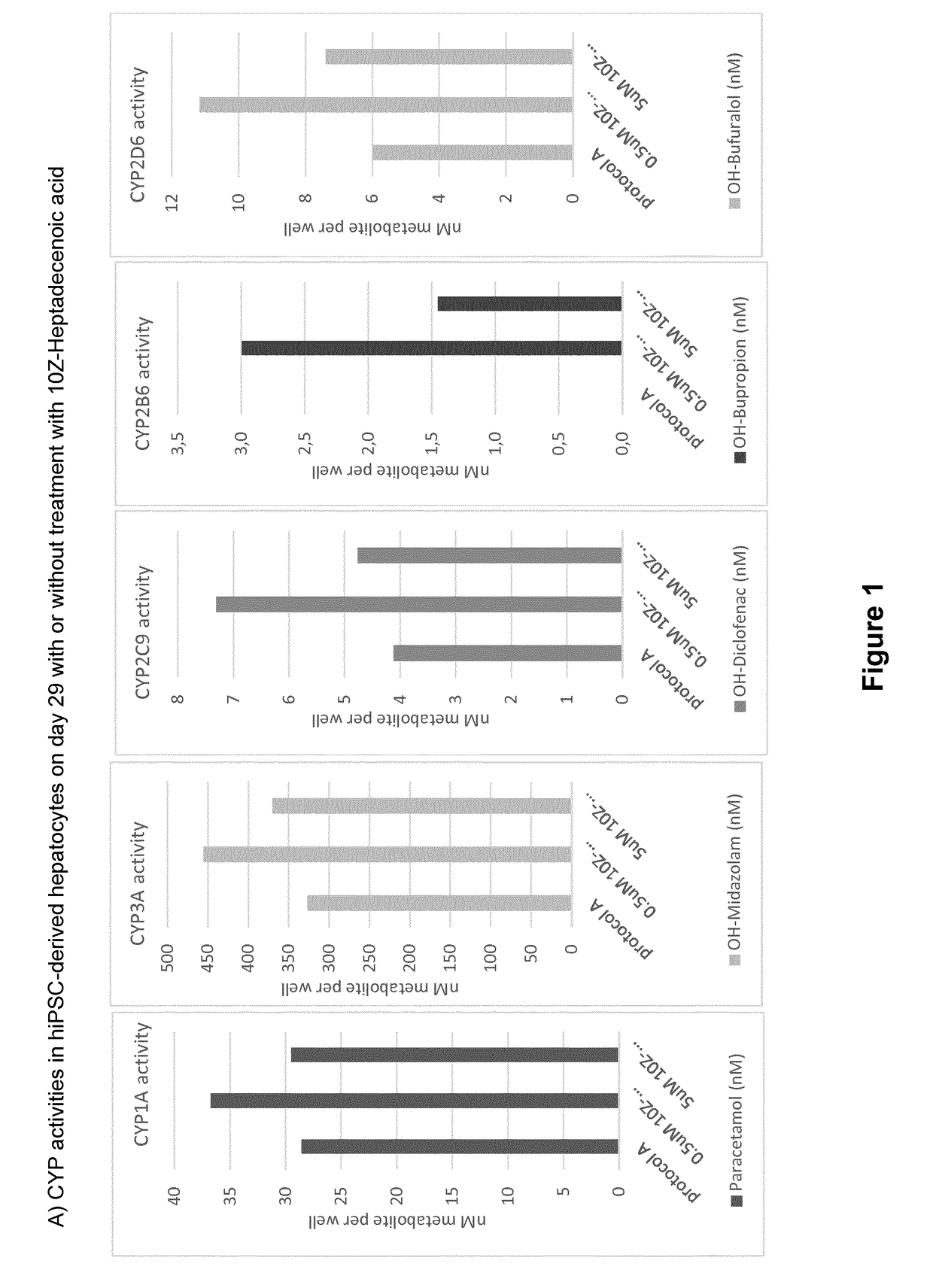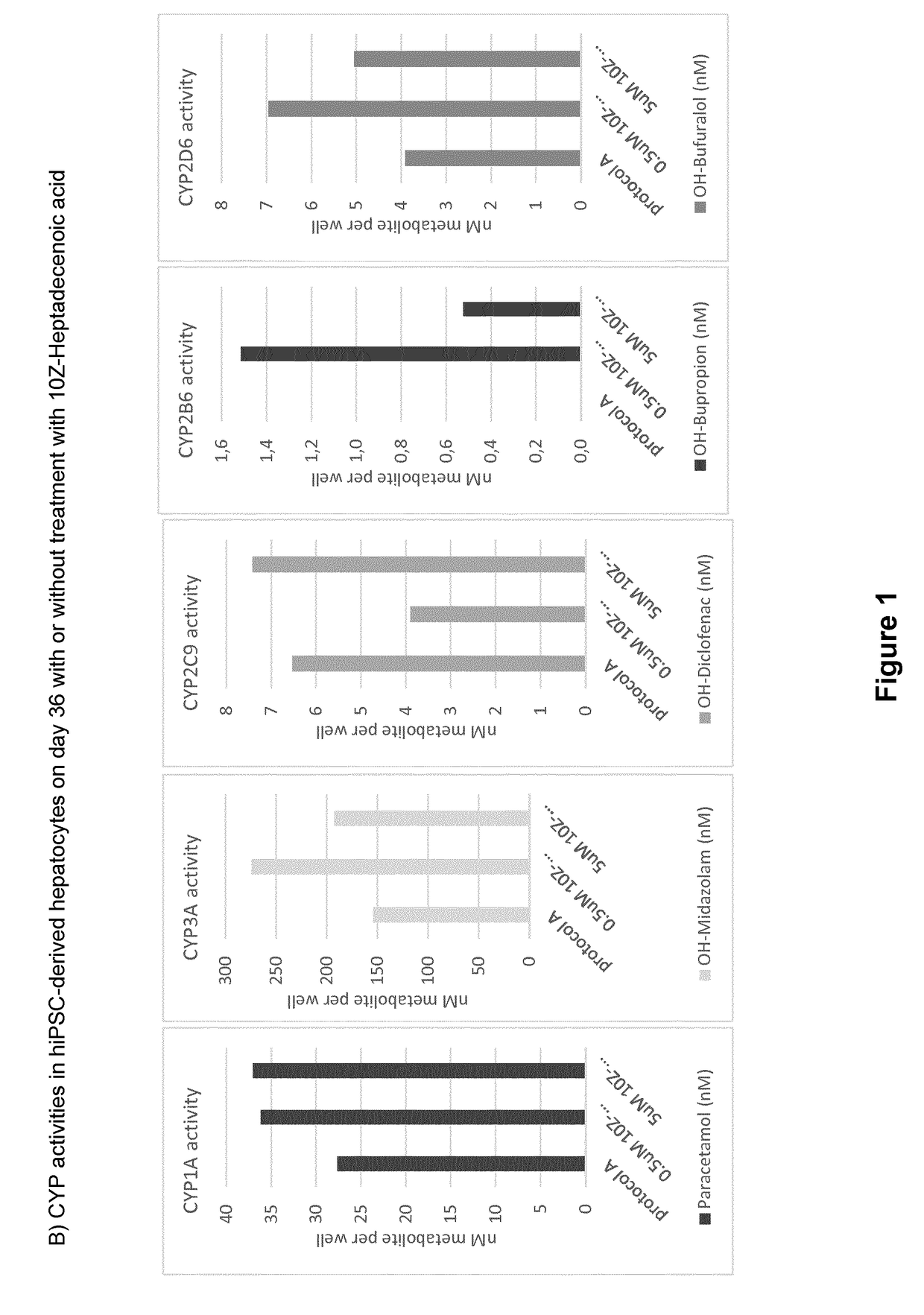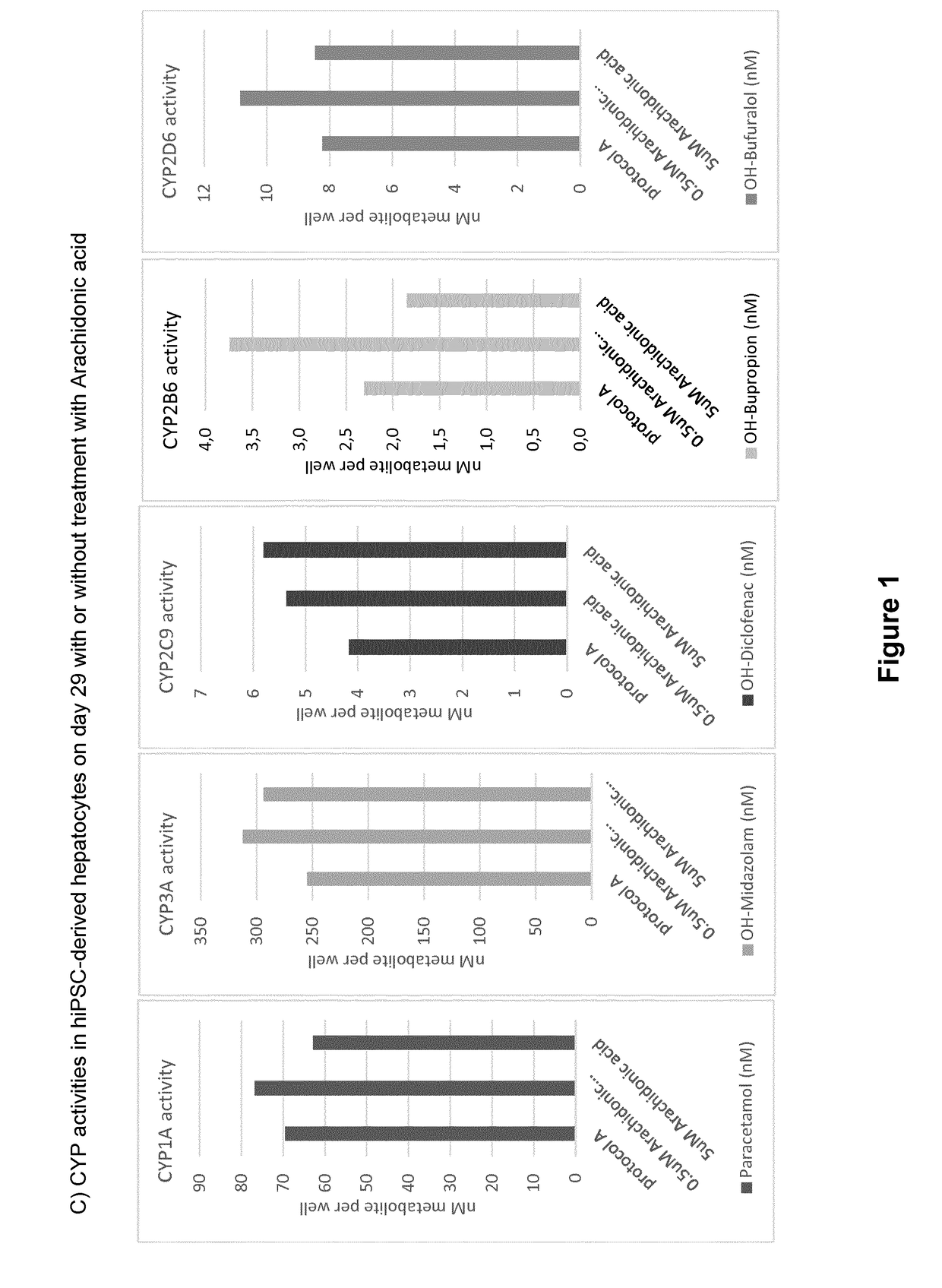Maturation of mammalian hepatocytes
a technology of hepatocytes and hepatocytes, which is applied in the field of directed differentiation and maturation of mammalian hepatocytes, can solve the problems of difficult to maintain cells in long-term culture, difficulty in obtaining consistent, homogeneous cell populations, and the like, and achieve the effect of improving the level of mature hepatic markers
- Summary
- Abstract
- Description
- Claims
- Application Information
AI Technical Summary
Benefits of technology
Problems solved by technology
Method used
Image
Examples
example 1
ce of hPS Cell Types
[0371]All hPS cells (as defined above) can be used as staring material for this invention. For the examples below in particular hepatocytes were derived in vitro from undifferentiated human embryonic stem cells (hESC) established on mEF feeder cells (Heins et al 2004) and maintained under feeder-free conditions. The cell lines used for this experiment could be, but are not limited to the hES cell lines SA121, SA167, SA181, SA461 (Cellartis AB, Göteborg, Sweden) and they can be propagated as described by Heins et al. 2004 and Caisander et al. 2006.
[0372]Along with hPS obtained from hESC, hiPS (human induced pluripotent stem) cells have also been used for the derivation of hepatocytes for the examples of this invention. The hiPSC line ChiPSC4 used in this invention was derived as followed: Human dermal fibroblasts (CRL2429, ATCC) were maintained in DMEM supplemented with 10% fetal bovine serum, 1× glutamax, 5 U / ml penicillin and 5 μg / ml streptomycin at 37° C. in a ...
example 2
iation of hPS Cell Types to Produce Hepatocytes
[0377]Hepatocytes may be derived from hPS cells by employing the following exemplary basic protocols A and B:
Protocol A:
[0378]Undifferentiated hPS cells are dissociated and seeded directly in day 0-medium onto a Fibronectin-based coating. The different mediums were prepared freshly and added day 0, 1, 2, 3, 4, 5, 7 and then every second or third day during the pre-hepatic phase, and differentiation and maturation phase.
Day 0
[0379]Pre-treatment medium
3 μM CHIR99021
[0380]5 μM ROCK inhibitor
Day 1
RPMI 1640 (+0.1% PEST+1% Glutamax)
1×B27
[0381]50 ng / ml Activin A
3 μM CHIR99021
5 μM LY294002
3 μM CHIR99021
Day 2
RPMI 1640 (+0.1% PEST+1% Glutamax)
1×B27
[0382]50 ng / ml Activin A
5 μM LY294002
[0383]10 nM 5-aza-2-deoxycytidine
Day 3
RPMI 1640 (+0.1% PEST+1% Glutamax)
1×B27
[0384]50 ng / ml Activin A
Day 4-7
RPMI 1640 (+0.1% PEST+1% Glutamax)
1×B27
[0385]50 ng / ml Activin A
[0386]The pre-treatment medium is available from Takara Bio Europe AB (Arvid Wallgrens Backe 20,...
example 3
Treatment of hiPSC-Derived Hepatocytes with 10Z-Heptadecenoic Acid, Arachidonic Acid, Calcifediol, Calcitriol, Cholecalciferol, CGP 52608, Docosahexaenoic Acid, PP1, PP2, D-Erythro-Sphingosine, and Tetradecanoic Acid
Procedure:
[0408]Following the basic protocol A, hiPS cell derived hepatocytes cultured on a Fibronectin-based coating were treated with 0.5 or 5 μM 10Z-Heptadecenoic acid, 0.5 or 5 μM Arachidonic acid, 5 μM Calcifediol, 5 μM Calcitriol, 0.2 or 0.5 μM Cholecalciferol, 5 or 50 μM CGP 52608, 0.5 or 5 μM Docosahexaenoic acid, 0.5, 1.25, 2.5, 5, or 10 μM PP1, 0.5 or 5 μM PP2, 0.5 or 5 μM D-erythro-Sphingosine, or 0.5 or 5 μM Tetradecanoic acid from day 21 of the differentiation protocol and onwards (FIG. 1).
[0409]On day 29 and 36 of the differentiation protocol, the cell cultures are subjected to a CYP activity assay according to the following protocol: Cells are washed twice with warm Williams's medium E w / o phenol red (+0.1% PEST). Then CYP activity assay, consisting of war...
PUM
| Property | Measurement | Unit |
|---|---|---|
| concentration | aaaaa | aaaaa |
| concentration | aaaaa | aaaaa |
| concentration | aaaaa | aaaaa |
Abstract
Description
Claims
Application Information
 Login to View More
Login to View More - R&D
- Intellectual Property
- Life Sciences
- Materials
- Tech Scout
- Unparalleled Data Quality
- Higher Quality Content
- 60% Fewer Hallucinations
Browse by: Latest US Patents, China's latest patents, Technical Efficacy Thesaurus, Application Domain, Technology Topic, Popular Technical Reports.
© 2025 PatSnap. All rights reserved.Legal|Privacy policy|Modern Slavery Act Transparency Statement|Sitemap|About US| Contact US: help@patsnap.com



